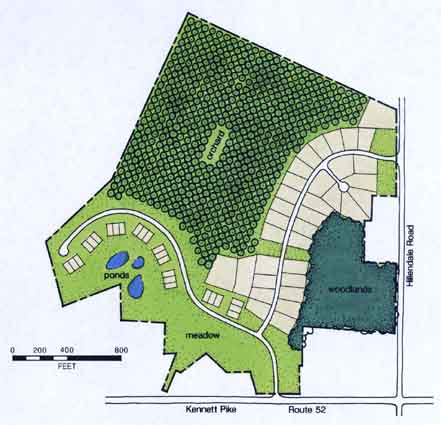 |
|||||||||||||||
 |
|
||||||||||||||
 Copyright 2007 LandChoices - All Rights Reserved |
The Ponds at Woodward Landowners turned down a developer's proposal that would have destroyed the above 50-acre orchard and received a 62% greater return by preserving the orchard in a conservation design subdivision they created called The Ponds at Woodward (PA). Photo courtesy Randall Arendt This 120-acre property with 57 homes illustrates how landowners who are concerned about the ultimate disposition of their family lands can craft a solution with the assistance of land trust staff, and market their vision to developers who are amenable to blending conservation and development.  As a result of this collaborative relationships, two-thirds of the property has been permanently protected, including ten acres of mature woodlands and a working orchard (producing apples and peaches) (shown at top left of site plan above) encompassing more than 50 acres. Moreover, the family's economic return was substantially increased over that which a conventional alternative would have generated. Under the township's two-acre zoning this land was capable of being subdivided into 57 tow-acre house lots, but it was also eligible for the Planned Residential Development (PRD) option under which four times as many dwellings could have been built. The two elderly brothers who owned the orchard asked the Brandywine Conservancy to comment on the concept plans submitted to them by potential developers, who had offered them $800,000 to purchase their property to build a 230-unit PRD. Not impressed by the quality of the site designs submitted to it for review by the developer's engineer, Conservancy staff offered to lay out a more sensitive site plan based on the standard two-acre density but with the flexibility provided by the PRD regulations. Through discussions with the owners, neighbors, and township officials, a number of concerns were identified, including maintaining the orchard, protecting the woodlands, retaining the farmhouse and barns, and buffering the public viewshed as seen from Kennett Pike. These four goals became the conservation areas around which the alternative plan was designed. Because everyone expected that the new 57-lot conservation design would not generate as high a return for landowners as would a 230-unit PRD plan, the township offered to contribute $50,000 to the brothers to help them make up the difference. The family's concept plan, featuring 70 percent open space, was then actively marketed to developers, five of whom were interviewed, and their past projects were examined. At the conclusion of these evaluations, the Harlan Corporation of Bryn Mawr was selected. Developers engaged in a small bidding war over this property and thus the brothers received multiple offers, the highest on being about $1.3 million. Although involving only one-quarter the number of lots possible on the PRD plan, the more sensitive design increased the brother's yield by 62 percent, rendering the township's subsidy unnecessary. Site plan courtesy Randall Arendt Excerpted from the book, GROWING GREENER, Putting Conservation in Local Plans and Ordinances. Author, Randall Arnedt. Publisher, Island Press, 1999. |
|
|||||||||||||
| Preserve Your Land | Conservation Subdivisions | Other Choices Home | About Us | News | Projects | Sponsors | Contribute | Contact Us | Links | Kids | Media Kit LandChoices • P.O. Box 181 • Milford, MI 48381 • info@landchoices.org Privacy Statement | www.landchoices.org |
|||||||||||||||



